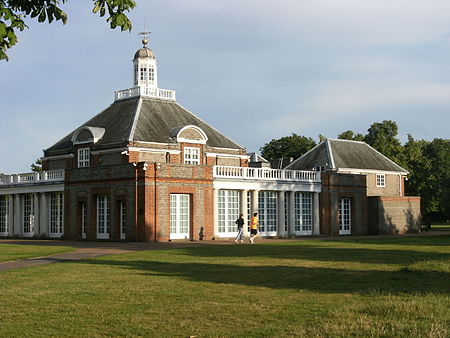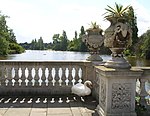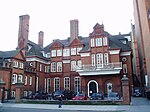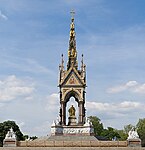The Frieze of Parnassus is a large sculpted stone frieze encircling the podium, or base, of the Albert Memorial in London, England. The Albert Memorial was constructed in the 1860s in memory of Prince Albert, the husband of Queen Victoria.
The frieze is named after Mount Parnassus, the favorite resting place in Ancient Greek mythology for the muses. It contains 169 life-size full-length sculptures, a mixture of low-relief and high-relief, of individual composers, architects, poets, painters, and sculptors from history. The depictions of earlier figures necessarily, were imaginary, although many of the figures were based on materials contained in a collection of artworks and drawings gathered for the purpose of ensuring authentic depictions, where this was possible.
The total length of the frieze is approximately 64 metres (210 feet). The frieze was intended to be the 'soul' of the memorial, and the memorial's designer, George Gilbert Scott, stated that he was inspired by the Hémicycle des Beaux Arts by Paul Delaroche. The memorial was not laid out precisely to directions of the compass, however, closely enough that the sides are referred to by direction. Musicians and poets were placed on the south side, with painters on the east side, sculptors on the west side, and architects on the north side.
Henry Hugh Armstead carved the figures on the south and east sides, the painters, musicians, and poets (80 in total), and grouped them by national schools. John Birnie Philip carved the figures on the west and north sides, the sculptors and architects (89 named figures, plus two generic figures), and arranged them in chronological order.
The carving was executed in situ, and was said by Scott to be "perhaps one of the most laborious works of sculpture ever undertaken". The initial contracts, agreed around 1864, had specified that the work was to be completed in four years for £7,781 15s. The eventual cost, however, exceeded this by some £2,000 and the work was not finished until 1872.
Large groups of figures of eminent persons from the past often decorate public buildings and monuments of the later nineteenth century, and some buildings such as the Walhalla temple in Bavaria and the Panthéon in Paris were dedicated to this purpose. Many figures of visual artists decorate the Victoria and Albert Museum close to the Albert Memorial at the other end of the "Albertopolis" complex. A mosaic frieze of more generalised figures from the arts runs round the circular Royal Albert Hall adjacent to the memorial. The Parnassus by Raphael (1511), opposite the philosophers of The School of Athens in the Vatican Raphael Rooms, is an earlier group portrait of great artists.









